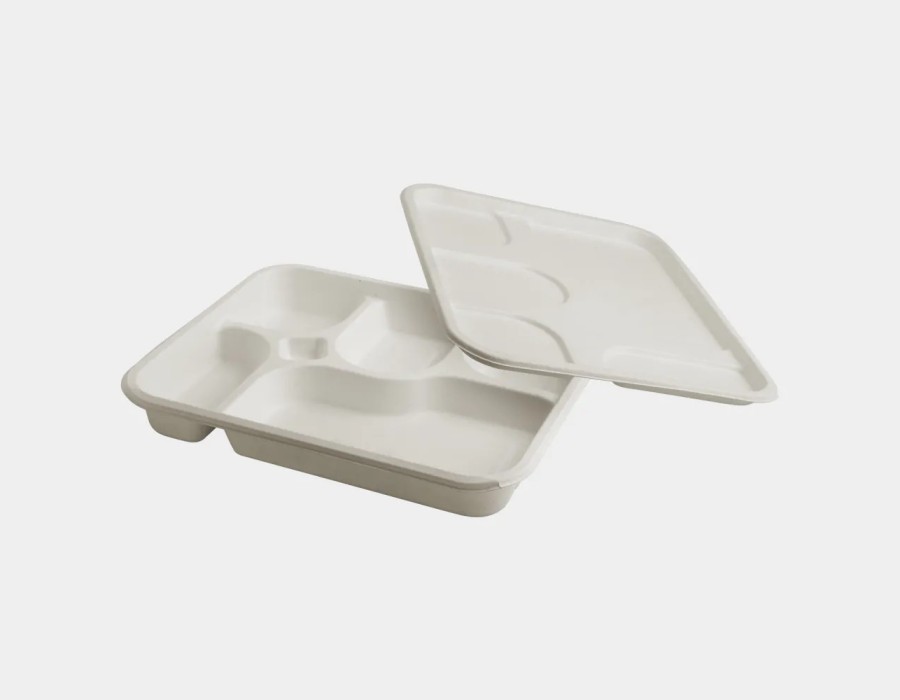As the demand for sustainable products grows, eco-friendly alternatives to single-use plastics are becoming essential. One such product is the 5-compartment disposable plate—a favorite for events, catering, and large gatherings. These plates offer the convenience of easy cleanup and separate food sections while increasingly being produced from sustainable materials. But the question remains: Are 55-compartment disposable plates truly sustainable? Let’s explore the environmental impact, materials, and benefits of choosing these eco-friendly options.
What Makes a 55-compartment Disposable Plate Sustainable?
To be considered sustainable, a disposable plate must ideally have minimal environmental impact throughout its life cycle—from production to disposal. Traditional plastic plates are derived from petroleum-based resources and take hundreds of years to decompose, often leaving harmful microplastics in the environment. In contrast, sustainable compartment plates are typically made from renewable materials like sugarcane bagasse, bamboo fiber, or compostable paper that decompose quickly, often within a few months under proper conditions.
Sustainable Materials Used in 5 Compartment Plates
The sustainability of these plates largely depends on the materials used. Several eco-friendly materials have replaced plastic, contributing to a more sustainable option for single-use dining.
Sugarcane Bagasse: A byproduct of sugar production, bagasse is highly renewable and compostable. Bagasse plates are sturdy, resistant to moisture and grease, and decompose in industrial composting facilities.
Bamboo Fiber: Fast-growing and requiring minimal water, bamboo is an excellent alternative to wood and plastic. Bamboo fiber plates are biodegradable and strong enough to hold hot and cold foods.
Palm Leaves: Plates made from pressed palm leaves are fully natural and biodegradable. They break down naturally and add no chemicals to the soil.
Using renewable materials not only reduces reliance on fossil fuels but also diverts agricultural byproducts from waste streams, giving them a new purpose in food packaging.
Compostability: A Key to Reducing Waste
One of the biggest environmental benefits of sustainable 55-compartment plates is their compostability. Unlike plastic that ends up in landfills for centuries, these plates break down relatively quickly.
Biodegradable and Compostable: Many 55-compartment plates are fully compostable in industrial composting facilities, breaking down within a few weeks. Some, like bagasse and palm leaf plates, are even suitable for backyard composting.
Reduced Landfill Waste: Because these plates decompose faster, they significantly reduce the waste sent to landfills, alleviating some of the strain on our waste management systems.
For event hosts and food vendors, compostable plates offer an easy solution to reduce the environmental impact of disposable tableware while meeting customer expectations for sustainability.
Energy-Efficient Production Process
Sustainable compartment plates also benefit from energy-efficient production processes, as materials like bagasse and bamboo require less energy to produce than plastic. For instance, bagasse utilizes the fibrous byproduct of sugarcane, effectively reducing waste in sugar production and minimizing resource use for new materials.
Lower Carbon Footprint: Using agricultural byproducts means less virgin material is needed, translating to lower carbon emissions overall.
Reduced Resource Extraction: With sustainable materials, manufacturers can avoid intensive processes like petroleum extraction, refining, and molding, which contribute heavily to pollution and greenhouse gas emissions.
Final Thoughts: Are They Truly Sustainable?
In summary, 55-compartment disposable plates made from materials like bagasse, bamboo, or palm leaves are far more sustainable than traditional plastic alternatives. They reduce waste, compost easily, and use renewable resources, making them an excellent choice for anyone looking to minimize their environmental impact. Though challenges remain—particularly around proper disposal—these plates represent a substantial improvement in the quest for sustainable, single-use dining solutions. As consumer demand for eco-friendly products continues to grow, so too will innovations in materials and accessibility, paving the way for a more sustainable future.





Comments